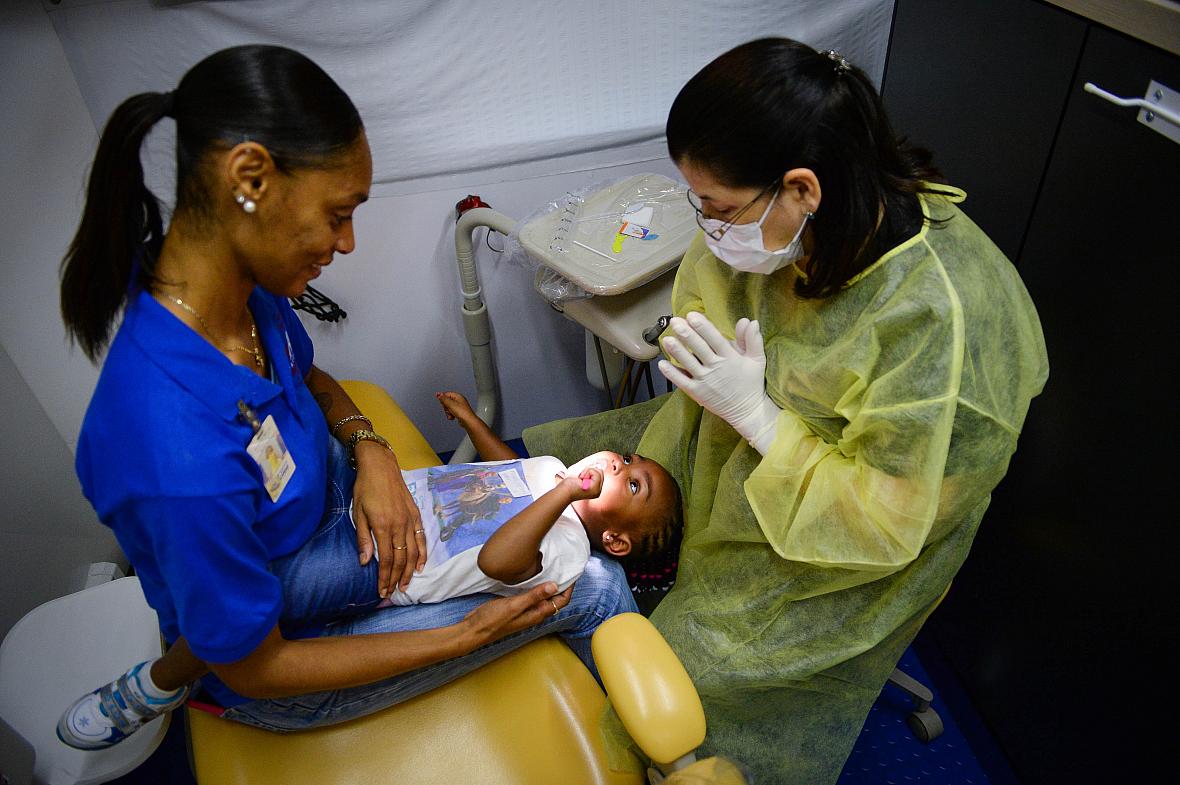Local, national efforts connect kids with dental care
Maggie Clark’s reporting on Florida’s Medicaid program for children was undertaken as a project for the Dennis A. Hunt Fund for Health Journalism, a program of the University of Southern California Center for Health Journalism.
Other stories in the series include:
Medicaid in Florida: 2 million kids. $24 billion battle.
Fighting for care in Florida's Medicaid system
An impossible choice: Doctors torn between patients and Florida's Medicaid system
2 Million Kids' series spurs support and quest for more data
Medicaid settlement: Florida will work harder to ensure health care for children

Shatorra Morris holds Kieraney Morris, 2, as Dr. Maria Pardo encourages Kieraney as she brushes her own teeth inside the MCR Health Services dental bus. Staff Photo/Rachel S. O'Hara
Not all states struggle with connecting Medicaid-enrolled children to dental care, and even within Florida, there are local efforts to address the crisis.
In Manatee County, a coalition of Head Start programs, the public schools and the federally qualified health center sponsored a dental van to bring cleanings and exams to students across the county.
A coalition of private and public entities in Sarasota County is working to put dental chairs in elementary schools in the county, and will pay for hygienists to offer services on campus.
Dentists from the University of Florida College of Dentistry set up shop in WIC (Women, Infants, and Children) offices throughout Alachua County, where program users come regularly to receive food stamps and nutritional counseling. The dentists offer cleanings and fluoride treatments for the children, and spend time educating parents on the importance of oral health care to their child’s development.
Dozens of federally qualified health centers in Florida were recently awarded $7.6 million in grant funding to hire dentists and support local efforts to increase access to dental care.
At the state level, however, coordination is lacking. Florida loosely sponsors programs in 46 counties to apply dental sealants on children in schools, but funding is limited. Instead, communities are encouraged to reach out to local philanthropies or apply for federal grants to fund their efforts.
“Many priorities of the Department of Health aren’t funded by general revenue,” said Christina Vracar, public health dental program administrator at the Florida Department of Health. “While dental health and sealant programs are a state priority, funding doesn’t necessarily come from the state.”
That is in sharp contrast to several states that have in recent years transformed their Medicaid dental programs.
Following similar Medicaid lawsuit settlements in Texas and Connecticut, both states raised reimbursement rates for dentists and saw large increases in the percentages of kids receiving dental care. Connecticut saw its access rates shoot from just 33 percent of kids receiving dental care in 2006, the year before the lawsuit settled, to 60 percent of kids receiving care in 2011, according to data submitted by Connecticut to the federal government.
National experts point to several policies that can help states increase the number of Medicaid-enrolled children receiving dental care.
The most important one, said Dr. Burton Edelstein, founder of the Children’s Dental Health Project, a Washington D.C.-based dental health advocacy group and the chair of the section of population oral health at the college of dental medicine at Columbia University, is to think less about just getting kids into the dental chair and more about making sure those at greatest risk receive the most help.
“Even though low-income kids are at a much higher risk and have more disease, most low-income kids are in pretty good shape,” Edelstein said. “If we were to re-envision Medicaid care for Florida kids, we’d start by stratifying children by risk of dental disease.
“The question policymakers should be asking is, ‘How do you design a system of care in Florida that puts the most intense resources on the kids that have the greatest risk, and maintain enough resources on preventive side for kids at the lowest risk to best use public dollars to get the best outcome?’”
[This story was originally published by the Herald-Tribune.]
